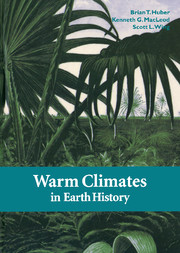Book contents
- Frontmatter
- Contents
- List of contributors
- Preface
- Part 1 Approaches to the study of paleoclimates
- Part II Case studies: latest Paleocene–early Eocene
- Part III Case studies: Mesozoic
- 8 Paleontological and geochemical constraints on the deep ocean during the Cretaceous greenhouse interval
- 9 Late Cretaceous climate, vegetation, and ocean interactions
- 10 Jurassic phytogeography and climates: new data and model comparisons
- Part IV Case studies: Paleozoic
- Part V Overview: climate across tectonic timescales
- Index
- Plate section
10 - Jurassic phytogeography and climates: new data and model comparisons
from Part III - Case studies: Mesozoic
Published online by Cambridge University Press: 06 July 2010
- Frontmatter
- Contents
- List of contributors
- Preface
- Part 1 Approaches to the study of paleoclimates
- Part II Case studies: latest Paleocene–early Eocene
- Part III Case studies: Mesozoic
- 8 Paleontological and geochemical constraints on the deep ocean during the Cretaceous greenhouse interval
- 9 Late Cretaceous climate, vegetation, and ocean interactions
- 10 Jurassic phytogeography and climates: new data and model comparisons
- Part IV Case studies: Paleozoic
- Part V Overview: climate across tectonic timescales
- Index
- Plate section
Summary
ABSTRACT
Leaves are a plant's direct means of interacting with the atmosphere, and their morphology is often attuned to and reflects prevailing environmental conditions. Although better understood and documented for angiosperms (or ‘flowering plants’), non-angiosperms also exhibit a phytogeographic pattern linked most strongly to the evaporation/precipitation ratio, a relationship often reflected in their foliar morphologies. We have used this to interpret Jurassic terrestrial climate conditions along a spectrum defined by climate-sensitive lithological end-members such as evaporites and coals. Global climate zones, or biomes, were determined by exploring the foliar morphology/climate relationship using multivariate statistical analysis.
Jurassic plant productivity and maximum diversity were concentrated at mid-latitudes, where forests were dominated by a mixture of ferns, cycadophytes, sphenophytes, pteridosperms, and conifers. Low-latitude vegetation tended to be xeromorphic and only patchily forested, represented by small-leafed forms of conifers and cycadophytes. Polar vegetation was dominated by large-leafed conifers and ginkgophytes which were apparently deciduous. Tropical everwet vegetation was, if present at all, highly restricted. Five main biomes are recognized from the data: seasonally dry (summerwet or subtropical), desert, seasonally dry (winterwet), warm temperate, and cool temperate. Their boundaries remained at near-constant paleolatitudes while the continents moved through them (south, in the case of Asia, and north, in the case of North America). Net global climate change throughout the Jurassic appears to have been minimal.
The data-derived results are compared here with a new climate simulation for the Late Jurassic. The use of more detailed paleogeography and paleotopography has improved the overall data/model comparisons.
- Type
- Chapter
- Information
- Warm Climates in Earth History , pp. 297 - 318Publisher: Cambridge University PressPrint publication year: 1999
- 31
- Cited by



